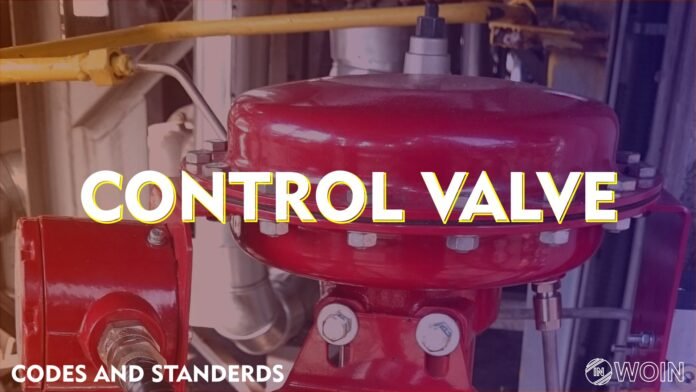Control valve selection is a very important process in the industry. There are many standards and codes that need to be followed for selecting the right control valve.
Introduction
The control valve is very important in Industry. It is responsible for translating controller signals into actions on the plant floor.
The control valve works as the final control element that helps to change manipulating variables for the process loop.
Selection of Control Valve is very important because properly selected Control Valve adds many benefits to the industry.
- Improve Efficiency of Plant
- Improve Quality of end Product
- Reduce Product waste
- Enhance Safety
For selecting the proper control valve as per application there are multiple codes and standards are need to be followed.
if you want more information on control valves then check out my post on the best resources to learn control valves.
Control Valve Codes and Standards
Minimum these standards are widely followed but it is not limited to. it changes according to the requirements of the application in the industry.
| Standard Organization | Standard Name |
|---|---|
| ASME (American Society of Mechanical Engineers) | IS/IEC 60079 Electrical Apparatus for Explosive Gas Atmosphere. IS/IEC 60529 Degree of Protection Provided by Enclosures. IEC 60534-3-2 Face to Face dimension of rotary valves except for the butterfly valves. IEC 60534-4 Seat leakage IEC 60534-8.3 Industrial process control valves, noise consideration, control valve aerodynamic noise prediction method IEC 60534-8.4 Industrial process control valves, noise consideration, prediction of noise generated by hydrodynamic flow IEC-61158 Fieldbus Standard for use in Industrial Control Systems IEC-61158-2 Physical layer specification and Service definition for Fieldbus FF 890 Function Block Application Process Part 1 FF 891 Function Block Application Process Part 2 FF 892 Function Block Application Process Part 3 FF 893 Function Block Application Process Part 4 FF 894 Function Block Application Process Part 5 IEC 61508 Functional Safety of Electrical/Electronic/ Programmable Electronic Safety-related Systems. IEC-61511 Functional safety instrumented system for the process industry sector IEC-61804 Function Blocks (FB) for Process Control: Electronic Device Description |
| ANSI/ FCI (American National Standard Institute/Fluid Control Institute) | FCI 70-2 Control Valve Seat Leakage |
| IEC (International Electro-Technical Commission) | 75.01.01 Flow equation for sizing control valves. 75.02 Control valve capacity test procedure. 75.04 Control Valve positioner stability 75.05.01 Control Valve Terminology 75.07 Laboratory measurement of aerodynamic noise generated by control valves 75.08.01 Face-to-face dimensions for integral flanged Globe-style control valve bodies (ASME Class 125,150,300 and 600) 75.08.02 Face-to-face dimensions for flangeless control valve (ASME Class 150,300 and 600) 75.08.04 Face-to-face dimensions for Buttweld-end globe style control valve (ASME Class 4500) 75.08.05 Face-to-face dimensions for Buttweld-end globe style control valve (ASME Class 150,300,600,900,1500 and 2500) 75.08.06 Face-to-face dimensions for flanged Globe-style control valve bodies (ASME Class 900,1500 and 2500) 75.11.01 Inherent flow characteristic and Rangeability of control valves. 75.19.01 Hydrostatic testing of control valves. 75.22 Face to center-line dimensions for flanged Globe-style Angle control valve bodies (ASME Class 150,300 and 600) 75.25.01 Test Procedure for Control valve response measurement for step inputs TR 75.25.02 Control valve response measurement for step inputs 75.13 Method of evaluating the performance of positioners with analog input signals and pneumatic output. 75.17 Control valve aerodynamic noise prediction. RP75.23 Considerations for evaluating control valve cavitation |
| ISA (International Society of Automation) | 75.01.01 Flow equation for sizing control valves. 75.02 Control valve capacity test procedure. 75.04 Control Valve positioner stability 75.05.01 Control Valve Terminology 75.07 Laboratory measurement of aerodynamic noise generated by control valves 75.08.01 Face-to-face dimensions for integral flanged Globe-style control valve bodies (ASME Class 125,150,300 and 600) 75.08.02 Face-to-face dimensions for flangeless control valve (ASME Class 150,300 and 600) 75.08.04 Face to face dimensions for Buttweld-end globe style control valve (ASME Class 4500) 75.08.05 Face-to-face dimensions for Buttweld-end globe style control valve (ASME Class 150,300,600,900,1500 and 2500) 75.08.06 Face-to-face dimensions for flanged Globe-style control valve bodies (ASME Class 900,1500 and 2500) 75.11.01 Inherent flow characteristic and Rangeability of control valves. 75.19.01 Hydrostatic testing of control valves. 75.22 Face to center-line dimensions for flanged Globe-style Angle control valve bodies (ASME Class 150,300 and 600) 75.25.01 Test Procedure for Control valve response measurement for step inputs TR 75.25.02 Control valve response measurement for step inputs 75.13 Method of evaluating the performance of positioners with analog input signals and pneumatic output. 75.17 Control valve aerodynamic noise prediction. RP75.23 Considerations for evaluating control valve cavitation |
| API (American Petroleum Institute) | 6 D Pipelines valves (Gate valve, Plug, Ball, and Check valves) 598 Inspection Requirements 609 Lug and wafer type, Butterfly valves. |
For the selection of Control Valve engineers need to focus on all the parts of the control valve. Here are the different parts of the control valve.
- Valve
- Positioner
- Actuators

Control Valve Selection Requirements
- Suitable Capacity of Flow Coefficient Cv calculated as per ISA 75.01
- Suitable Rangeability
- Proper Shutoff Pressure to Actuator
- Materials for body, trim, packing box, and other parts as Per process conditions
- Cavitation, flashing, and noise in the Limiting the range
- Type of Positioner
- Control valve Noise Calculation as pe ISA 75.17
- Failure actions
- Opening type of Control Valve
- Shut-off leakage of valves shall be in accordance with FCI 70.2
- Type of Actuator use (force-balance type or smart digital type or field bus type)
- Control Valve Leakage
- Actuators shall be selected to achieve specified valve failure positions
- valves shall be tested in accordance with API 589,
- hydro-tested to ASME B 16.34 clause 7.1
- leak tested to ASME / FCI 70.2.
EndNote: –
I hope now you get over all the general ideas about the selection process of the control valve. and which are the standards and codes that need to be followed for the selection of the control valve.
You can also check my Best YouTube Channels to learn about Functional safety-related topics.


